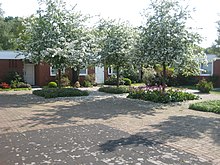Gartenhofsiedlung (Hanover)

The Gartenhofsiedlung in Hanover is a settlement that was built in the 1960s and is now a listed building in the Hanover district of Marienwerder . It is located on the Garbsener Landstrasse in the direction of Garbsen in the forest behind the Marienwerder monastery at the Hinüberschen garden .
history
The garden courtyard settlement was built around 1965 far away from the center of the Lower Saxony state capital, with its large residential complexes , which was converted into a car-friendly city in the 1950s . When general prosperity increased after the first years of development in the post-war period, the need for new forms of living in modern settlements arose at the same time. For example, the garden courtyard settlement in Marienwerder on the former farmland behind the monastery forest was intended to provide the townspeople with a balance between the lively city life and the old village of Garbsen.
In the row house settlement with its flat roofs , which were felt to be progressive at the time, a row of houses with its own artist studios was created , many behind high brick walls . The demand for structures promoting the private sphere was initially subdued, but after “[…] in the wake of the economic miracle […] the men had climbed the ladder of success early”, “[…] many city officials, artists and scientists and honorable personalities of the Stadtgesellschaft ”in the Gartenhofsiedlung, for example the former City Director Martin Neuffer . The social pedagogue Helmut Kentler compared his residential area with a campsite: "[...] Everyone has their caravan here and a little before that". A large number of the first settlers between Quantelholz and Westermannweg were still alive in 2016 during the neighborhood festival organized by Wolfgang Kupfer for the 50th anniversary of the first move into the garden courtyard.
The Gartenhofsiedlung was only placed under protection as an architectural monument after 1985, the year the corresponding volume of the monument topography of the Federal Republic of Germany was published .
In contrast, life in the second large new building area near Marienwerder Monastery, the Große Pranke , which was built around the same time as the garden courtyard settlement, was less successful in the history of the district.
Personalities (selection)
- From 1966 Dagmar Albrecht and her family lived in the Gartenhofsiedlung, Westermannweg 22 .
- Siegfried Zimmermann , sculptor
literature
- Dagmar Albrecht (Ed.) Et al .: Today in Marienwerder. A district book about different people, historical sights, the environment and nature (199 pages, with drawings by Gisela Blumenbach and others as well as photographs by Kristin Beier and others). D. Albrecht, Hannover-Marienwerder 1992.
Web links
Individual evidence
- ↑ a b c d Mario Moers: Private life begins behind the wall / The Gartenhofsiedlung in Marienwerder is 50 years old - and its residents celebrate it with a big party. In: Stadt Anzeiger Nord , supplement to the Hannoversche Allgemeine Zeitung from August 18, 2016, pp. 1, 3.
- ↑ Compare Gerd Weiß: Marienwerder. In: Monument topography of the Federal Republic of Germany, architectural monuments in Lower Saxony, City of Hanover, Part 2, Volume 10.2, ed. by Hans-Herbert Möller , Lower Saxony State Administration Office - publications by the Institute for Monument Preservation . Friedr. Vieweg & Sohn, Braunschweig / Wiesbaden 1985, ISBN 3-528-06208-8 , p. 69ff .; as well as Marienwerder in the addendum directory of architectural monuments acc. § 4 ( NDSchG ) (excluding architectural monuments of the archaeological monument preservation ) / Status: July 1, 1985 / City of Hanover. P. 16.
- ↑ Dagmar Albrecht (Ed.): Today in Marienwerder. A district book about different people, historical sights, the environment and nature. D. Albrecht, Hannover-Marienwerder 1992, p. 2, 199.
Coordinates: 52 ° 24 ′ 19.9 " N , 9 ° 37 ′ 26.3" E
